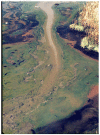Portrait of a Geothermal Spring, Hunter's Hot Springs, Oregon
- PMID: 25633225
- PMCID: PMC4390855
- DOI: 10.3390/life5010332
Portrait of a Geothermal Spring, Hunter's Hot Springs, Oregon
Abstract
Although alkaline Hunter's Hot Springs in southeastern Oregon has been studied extensively for over 40 years, most of these studies and the subsequent publications were before the advent of molecular methods. However, there are many field observations and laboratory experiments that reveal the major aspects of the phototrophic species composition within various physical and chemical gradients of these springs. Relatively constant temperature boundaries demark the upper boundary of the unicellular cyanobacterium, Synechococcus at 73-74 °C (the world-wide upper limit for photosynthesis), and 68-70 °C the upper limit for Chloroflexus. The upper limit for the cover of the filamentous cyanobacterium, Geitlerinema (Oscillatoria) is at 54-55 °C, and the in situ lower limit at 47-48 °C for all three of these phototrophs due to the upper temperature limit for the grazing ostracod, Thermopsis. The in situ upper limit for the cyanobacteria Pleurocapsa and Calothrix is at ~47-48 °C, which are more grazer-resistant and grazer dependent. All of these demarcations are easily visible in the field. In addition, there is a biosulfide production in some sections of the springs that have a large impact on the microbiology. Most of the temperature and chemical limits have been explained by field and laboratory experiments.
Figures



















Similar articles
-
Anoxygenic Phototrophs Span Geochemical Gradients and Diverse Morphologies in Terrestrial Geothermal Springs.mSystems. 2019 Nov 5;4(6):e00498-19. doi: 10.1128/mSystems.00498-19. mSystems. 2019. PMID: 31690593 Free PMC article.
-
Distribution and Genomic Variation of Thermophilic Cyanobacteria in Diverse Microbial Mats at the Upper Temperature Limits of Photosynthesis.mSystems. 2022 Oct 26;7(5):e0031722. doi: 10.1128/msystems.00317-22. Epub 2022 Aug 18. mSystems. 2022. PMID: 35980085 Free PMC article.
-
Temperature impacts community structure and function of phototrophic Chloroflexi and Cyanobacteria in two alkaline hot springs in Yellowstone National Park.Environ Microbiol Rep. 2020 Oct;12(5):503-513. doi: 10.1111/1758-2229.12863. Epub 2020 Jul 26. Environ Microbiol Rep. 2020. PMID: 32613733 Free PMC article.
-
Microbiological studies of hot springs in India: a review.Arch Microbiol. 2018 Jan;200(1):1-18. doi: 10.1007/s00203-017-1429-3. Epub 2017 Sep 8. Arch Microbiol. 2018. PMID: 28887679 Review.
-
Fischerella thermalis: a model organism to study thermophilic diazotrophy, photosynthesis and multicellularity in cyanobacteria.Extremophiles. 2019 Nov;23(6):635-647. doi: 10.1007/s00792-019-01125-4. Epub 2019 Sep 11. Extremophiles. 2019. PMID: 31512055 Review.
Cited by
-
Coaggregation Occurs between a Piliated Unicellular Cyanobacterium, Thermosynechococcus, and a Filamentous Bacterium, Chloroflexus aggregans.Microorganisms. 2024 Sep 19;12(9):1904. doi: 10.3390/microorganisms12091904. Microorganisms. 2024. PMID: 39338578 Free PMC article.
-
Anoxygenic Phototrophs Span Geochemical Gradients and Diverse Morphologies in Terrestrial Geothermal Springs.mSystems. 2019 Nov 5;4(6):e00498-19. doi: 10.1128/mSystems.00498-19. mSystems. 2019. PMID: 31690593 Free PMC article.
-
High diversity of thermophilic cyanobacteria in Rupite hot spring identified by microscopy, cultivation, single-cell PCR and amplicon sequencing.Extremophiles. 2019 Jan;23(1):35-48. doi: 10.1007/s00792-018-1058-z. Epub 2018 Oct 4. Extremophiles. 2019. PMID: 30284641
-
Mechanistic Insights Into Post-Translational α-Keto-β-Amino Acid Formation by a Radical S-Adenosyl Methionine Peptide Splicease.Angew Chem Int Ed Engl. 2025 Feb 3;64(6):e202418054. doi: 10.1002/anie.202418054. Epub 2025 Jan 10. Angew Chem Int Ed Engl. 2025. PMID: 39688170 Free PMC article.
-
Phototrophic Co-cultures From Extreme Environments: Community Structure and Potential Value for Fundamental and Applied Research.Front Microbiol. 2020 Nov 6;11:572131. doi: 10.3389/fmicb.2020.572131. eCollection 2020. Front Microbiol. 2020. PMID: 33240229 Free PMC article.
References
-
- Wingard C.E., Schiller J.R., Miller S.R., Castenholz R.W. An Inventory of the Photosynthetic Microorganisms of Hot Springs of Borax Lake, Oregon and Selected Hot Springs of the Northern Great Basin, USA. The Nature Conservancy; Arlington, VA, USA: 1996. p. 40.
-
- Mariner R.H., Rapp J.B., Willey L.M., Presser T.S. The Chemical Composition and Estimated Minimum Thermal Reservoir Temperature of Selected Hot Springs in Oregon. US Geological Survey; Menlo Park, CA, USA: 1974. p. 27.
-
- Peary J., Castenholz R.W. Temperature strains of a thermophilic blue-green alga. Nature. 1964;202:720–721. doi: 10.1038/202720a0. - DOI
-
- Ward D.M., Miller S.R., Castenholz R.W. Cyanobacteria in geothermal habitats. In: Whitton B.A., editor. Ecology of Cynobacteria II. Springer; New York, NY, USA: 2012. pp. 39–63.
Publication types
LinkOut - more resources
Full Text Sources
Other Literature Sources

